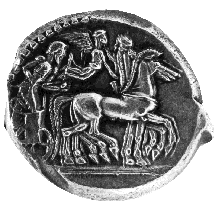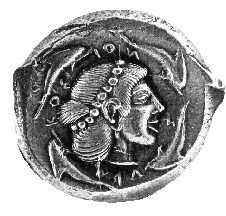



(15) Syracuse, Sicily (Italy) - AR tetradrachm, c. 485-465
B.C., 17.33 g. (inv. 91.029).
Obverse: Quadriga r., Nike crowning horses.
Reverse: Head of Arethusa r., surrounded by four dolphins;
![]() : of the Syracusans.
: of the Syracusans.
Provenance: Edward Gans, 1959.
Bibliography: E. Boehringer, Die Münzen von Syrakus
(Berlin-Leipzig 1929) 312.
Gelon, tyrant of Gela, captured Syracuse and transferred his capital there
in 485 B.C. With his defeat of the Carthaginians in the Battle of Himera
in 480 B.C. he acquired considerable wealth, which resulted in the massive
production of these tetradrachms.
This coin illustrates the two themes that became commonplace in Syracusan
coins and influenced the coinage of other Sicilian cities. The obverse depicts
a quadriga or four-horse chariot with Nike crowning its horses in victory.
The quadriga originally may have referred to the favorite pastime of the
Syracusan aristocracy, the Gamoroi, who bred horses and sent chariots to
compete in the Olympic games, but on these coins it may also refer specifically
to an Olympic victory of Gelon in 488 B.C.
The representation of Arethusa on the reverse refers to her legendary connection
with Syracuse. A nymph of Elis in the Peloponnese, she was pursued by the
river god Alpheios. To escape him, she withdrew under the sea, finally emerging
at Syracuse. She was transformed into the fresh water nymph of the island
of Ortygia, the earliest settled portion of Syracuse. The dolphins encircling
her on the coin perhaps refer to the location of her spring on Ortygia,
surrounded by the sea. Although the coin dates from the Early Classical
period, it retains characteristics of the Archaic style, in the linear,
patterned detail of the bodies of the charioteer and horses on the obverse
and in the almond eye and Archaic smile of Arethusa on the reverse.
K.S.



All contents copyright (c) 1996.
Lawrence University
All rights reserved.